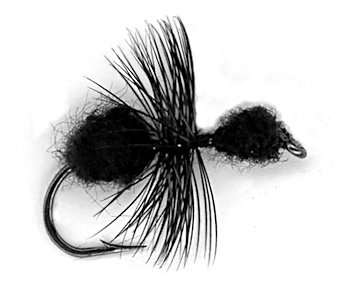The Black Ant Dry Fly
Every serious fly fisher should carry a selection of flying ants in their fly box at the first sign of new leaves on trees and bushes. These tender leaves attract aphids that leave sweet droppings ants love to sip. Its also a signal that there will soon be a flying ant fall and trout go nuts over flying ants.

ANT DRY FLY PATTERNS. Hook size 18 16 14 12 10 - $US each
BLACK ANT DRY FLIES
A Scientist studied the eating habits of rainbow, brown and Brook trout during the months of July/August and found that no other food dominated their menu so heavily as ants. The proportion in some of the trout was as much as 80%. Flying ants swarm at this time of the year. They 'rain' down on lakes and rivers by their billions and attract fish to the surface. At the beginning of a swarm when the ants fall rather sparsely, the fish are easy to catch. During the peak of the swarm the real ants are too numerous and a fish rarely takes an imitation by mistake, but the situation changes again towards the end of the swarm. For weeks after the fish are obsessed with this source of food and ant flies are remain one of the best flies to use.
Even when there are no swarms have a look at over hanging trees. If ants are
climbing up their trunks, exploring the leaves for food, some will fall. A
floating ant fly might just tempt that hungry trout lurking in the shade. The English Fly Fishing Shop carries a range of black and red ant flies. Ants may be fished very simply, like freely drifting dry flies. As the fish find them easily enough, no special tricks are required.
It may seem strange that trout would prefer to eat land based insects over the many aquatic bugs available to them. You must remember that unlike hatching mayflies they are available to the fish virtually all year round. Trout have an entire season to learn what they look and taste like. They must be considered by the fish as an abundant dependable surface floating pray. Ant patterns will catch trout anywhere unlike mayfly patterns where you should try and match the hatch. Even when there are hatches on the water some time during the day there will be at least one lengthy period when few flies are hatching. This normally occurs in the afternoon. This is the time to get out an ant pattern. If you come across a picky feeder who will not take your mayfly pattern, do not abandon it without showing the fish an ant fly. Once when I was on vacation I arrived on a river completely unprepared for the large hatch of tiny Blue winged olives. I didn't have any dry fly small enough. I tried a few ant flies and managed to tempt a few of the feeders away from the mayfly feast.
FISHING MOUNTAIN LAKES
The secret to understanding Summer fishing in mountain lakes is to remember
that the wind blows up hill. What is he talking about I hear you saying to
yourself. What on earth has that got to do with fishing? It has everything to do
with Mountain Fishing. Terrestrial insects like grass hoppers, beetles and ants
make up 80% of the summer diet of trout and grayling in alpine mountainous
environments. They are carried up the mountain by the wind and deposited in the
high altitude lakes. (the biologists call them 'upslope blow-ins') Combine this
with with the amount of emergent or adult forms of aquatic insect life taken in
the surface film then you find that 90% of their food comes from the top. The
mountain lake trout cruise and search for food on the water surface film and
this is where you should be fishing.
The upslope winds occur when the high ridges receive the morning sun whilst the valleys are still in shade. The cool air of the valley bottom is sucked up to the ridges as the layers mix in an effort to equalize the air temperature. The greater the temperature disparity the stronger the winds. Bug falls are greater in the afternoon. The lake is a heat sink as it is cooler than the surrounding land and therefore creates a thermal variation and downdraft.
Ants are easily plucked from the surface by the winds even by mild winds. They are often the most numerous insect dropped on the water surface because of their low weight. Production of single cell organisms are low and rooted plants are sometimes absent due to the low average temperature . Two winged diptera midge flies are the most common aquatic insects. There are no major hatches of Caddis, Damselflies or Mayflies on many of these lakes. If it has rained within the last 24 hours runoff from a rainstorm will bring drowned spiders, bees, worms and insects into the lake. A Timberwolf, black soft hackle spider or San Juan Worm will bring results fished dead drift. On windless days flying insects still blunder their way onto the water. Just leave a pan of water out for a day and you will find moths, flies and bees floating in the surface


Fly Fishing books

